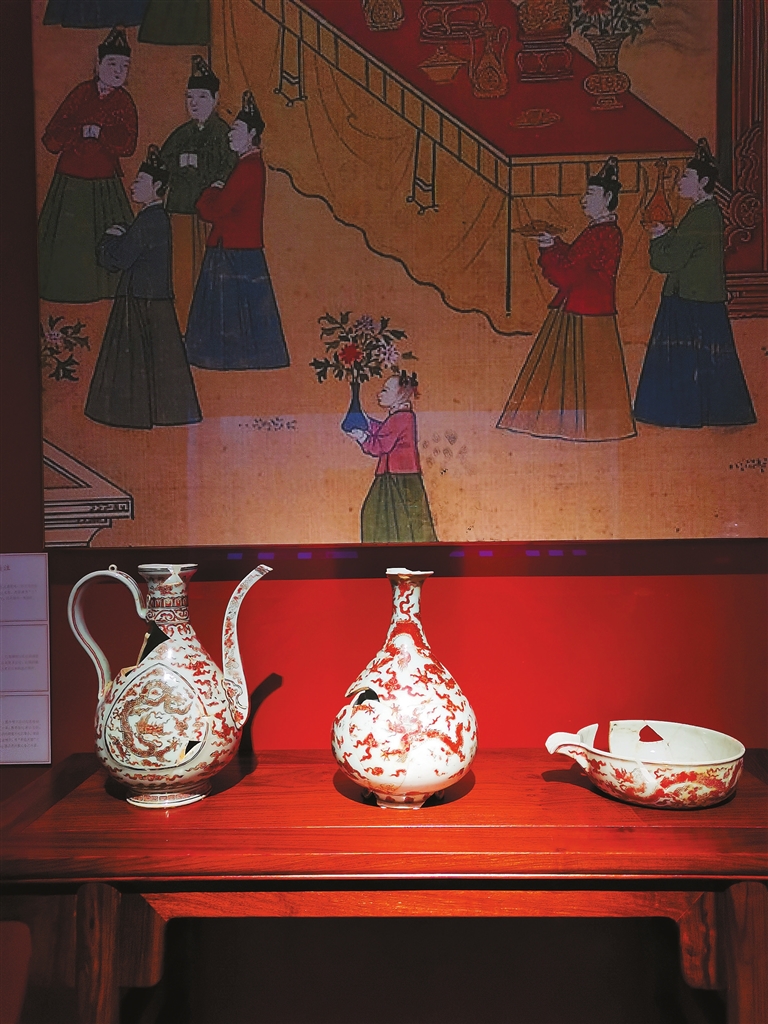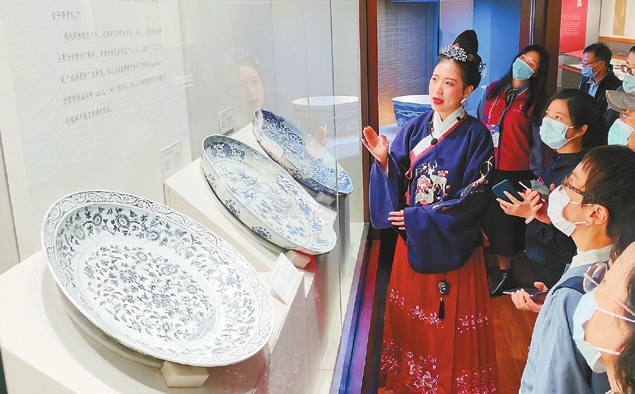



Cao Zhen caozhen0806@126.com THE Ming Dynasty (1368-1644) porcelains are some of the world’s most desirable works of art due to their fine ceramics, intricate designs and craftsmanship. Now Shenzheners can admire a dazzling beautiful exhibition of Chinese porcelains from the 15th century at the Shenzhen Museum’s ancient art outlet. “The Great Ming • Imperial Porcelains,” the four-month-long exhibition of more than 300 items, is hosted by the Shenzhen Museum which has a longtime research on ancient porcelains. The exhibition is also co-organized by the National Museum of China, Capital Museum China, the Beijing Summer Palace Management Office, Tianjin Museum, Shanghai Museum, Jingdezhen Ceramics Archaeology Institute, Zhejiang Provincial Institute of Cultural Relics and Archaeology, and the Shenzhen Municipal Cultural Heritage Protection Center. The Ming Dynasty porcelain development benefited from the booming economy of the 15th century and the surge in demand for quality porcelains both at home and abroad. After 97 years of rule by the ethnic-Mongolian Yuan Dynasty (1271-1368), China returned to Han Chinese rule and resumed the Han ritual system, etiquette and norms. The Ming Dynasty court needed large quantities of porcelains for rituals, banquets and exchanges, and pottery art took on a new lease of life. Imperial kilns in the great porcelain town of Jingdezhen in modern Jiangxi Province were rebuilt to keep the court supplied with particularly exquisite porcelains. At that time, the vogue for porcelains with colorful designs rapidly replaced the old taste of monochromes that were characteristic in the Song Dynasty (960-1279), and imperial porcelains were marked with the reign mark of the emperor himself. In addition to Jingdezhen, the imperial court also ordered porcelains from kilns in Longquan (in modern Zhejiang Province), Junzhou (in modern Henan Province) and Cizhou (in modern Hebei Province). The Yongle and Xuande reigns in the early 15th century were known as the golden age of imperial porcelains in the Ming Dynasty. The rewards to Tibetan monks, officials and foreign envoys, and diplomatic exchanges via Zheng He’s seven-time voyages to foreign countries, all required large quantities of porcelains. The Yongle and Xuande periods ushered in an astonishing time of artistic creativity in porcelain production. The mid-15th century was regarded as a “blank period” for porcelains due to political turmoil. But when it came to the Chenghua reign (1465-1487) when politics was stable, porcelain manufacturing started to revive and the Chenghua porcelains were regarded as more elegant and exquisite than those in Xuande. “The imperial porcelains played an important role in court life, ritual activities, ethnic relations and diplomatic exchanges in the Ming Dynasty. The exhibits here are abundant and diverse, telling us the fascinating story behind the porcelains and the relationship between wares and humans,” said Guo Xuelei, deputy director of the Shenzhen Museum. The exhibition is divided into three parts in the themes of rituals, banquets and court life. From huge jars to tiny bird feeders, the porcelains with elegant curves and clean lines could take just about any form in addition to the traditional wine vessels, plates, bowls, and cups long seen in Chinese ceramics. There is a blue-and-white incense burner lid in the form of a mountain. Apertures, often hidden within the craggy rock face, would emit the smell of burning incense and animate the visual scene with curls of rising smoke. Popular pattern subjects on the porcelains include flowers, fish, twigs, children and chickens. Large jars and bowls with patterns of the dragon symbolize imperial power. There was an influence of foreign art on the Ming porcelain patterns such as the floral patterns of West Asia and Arabic texts, illustrating the wide exchanges between the Ming Dynasty and foreign countries in Asia and the Middle East. In addition to typical blue-and-white porcelains, visitors can also admire other color-glazed wares, such as porcelains with underglazed red patterns, thin-walled sweet white glazed porcelains and doucai (clashing colors) porcelains. The quality of the refined sweet white porcelain has a visually appealing color, like soft white sugar, inspiring delicate feelings, hence its name “sweet white.” Doucai is a combination of underglaze and overglaze coloring crafts, requiring two firings. The overglazed colors of red, yellow or green contrast nicely with the underglazed blue color. Dates: Until April 10, 2022 Hours: 10 a.m.-6 p.m., closed Mondays Booking: WeChat account “iszbwg” Venue: Shenzhen Museum (of Ancient Art), Futian District (福田区深圳博物馆古代艺术馆) Metro: Line 9 to Hongling South Station (红岭南站), Exit A | 
